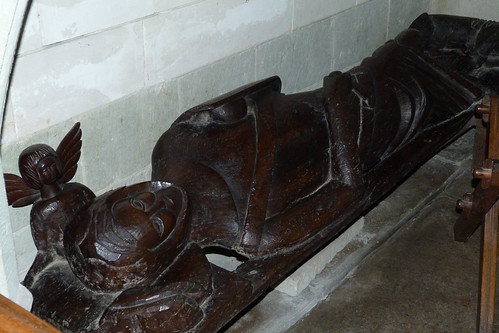 Submitted by PALLAS ATHENA -... on
Submitted by PALLAS ATHENA -... on

Lucy Lightfoot left her horse tethered at the gateway to Gatcombe Church, and was never seen again ... Did an electrical storm induce a timeslip?
The Legend of Lucy Lightfoot
by Mark Griffin
In the sanctuary at the East end of the Gatcombe Church (Isle of Wight, UK) lies the carved wooden effigy of Edward Estur, a crusader night who died in Palestine in 1303. His feet lie crossed on the back of a faithful dog. His eyes stare into the middle distance, lost in the timeless thought. An angel sits behind his right ear, looking over him. Nobody knows how the knight ended up in the church.

In the early nineteenth century Lucy Lightfoot, a local girl, who lived just over the down in Bowcombe began to attend services at the church. She was gorgeous, with flowing black hair and an easy laugh. Many tried to win her hand and many failed. Lucy never felt ready to take a lover.
Often though, after service, she would stay on in the church and sit in the sanctuary next to the knight, staring at him and stroking his face and apologising to him. The villagers began to take notice of her strange bond with the effigy and gently teased her for it. All she could do was shrug her shoulders and say that she found him unbearably beautiful.
Then one morning - the 13th June 1831 - to be precise, whilst out riding Lucy was caught in a huge storm, prompted by a total eclipse of the sun. The sky turned black, the winds blew huge and the rain began to fall. Frightened by the encroaching darkness she rode hard to the church, tethered her horse and sought refuge inside. It was the last anybody ever saw of her.
Two days later George Brewster, a local farmhand, noticed the horse looking scared and famished, still tied to the lynch gate. He raised the alarm and a search for Lucy was started - but to no avail. Her family were devastated.
Also of note is the detail that a steel misericord attached to a wooden effigy of Edward Estur was found shattered after her disappearance. A valuable chrysoberyl set in lodestone on the hilt was found to be missing. (source - Wikipedia)
Years passed and then in 1865 a distinguished Medievalist scholar Samuel Trelawney came across a document dated 1297 recording how the King of Cyprus had been in London recruiting English knights for the sacking of Alexandria. One of those volunteers was Edward Estur and, accompanying him to Cyprus went a dark haired beauty from Carisbrooke Castle on the Isle of Wight going by the name of .... Lucy Lightfoot.
They parted at Larnaca. Lucy vowing to wait patiently for his return. Edward sailed bravely on but sadly with the battle raging and the town repelling all advances, he took a blow to the head, suffered severe amnesia and was transported straight back to England to convalesce. Lucy waited for three years and then, believing him to be dead, married a Sicilian fisherman. She never returned to these shores. At least not in her first lifetime.
http://dramastmarys.blogspot.com/2011/09/legend-of-lucy-lightfoot.html
Post note: An intense electrical storm, a piece of lodestone apparently reduced to nothing. a legend that seems to imply some kind of side-step in time - these are items that can perhaps give us a clue to some of the mysteries of the Isle of Wight.
- 856 reads